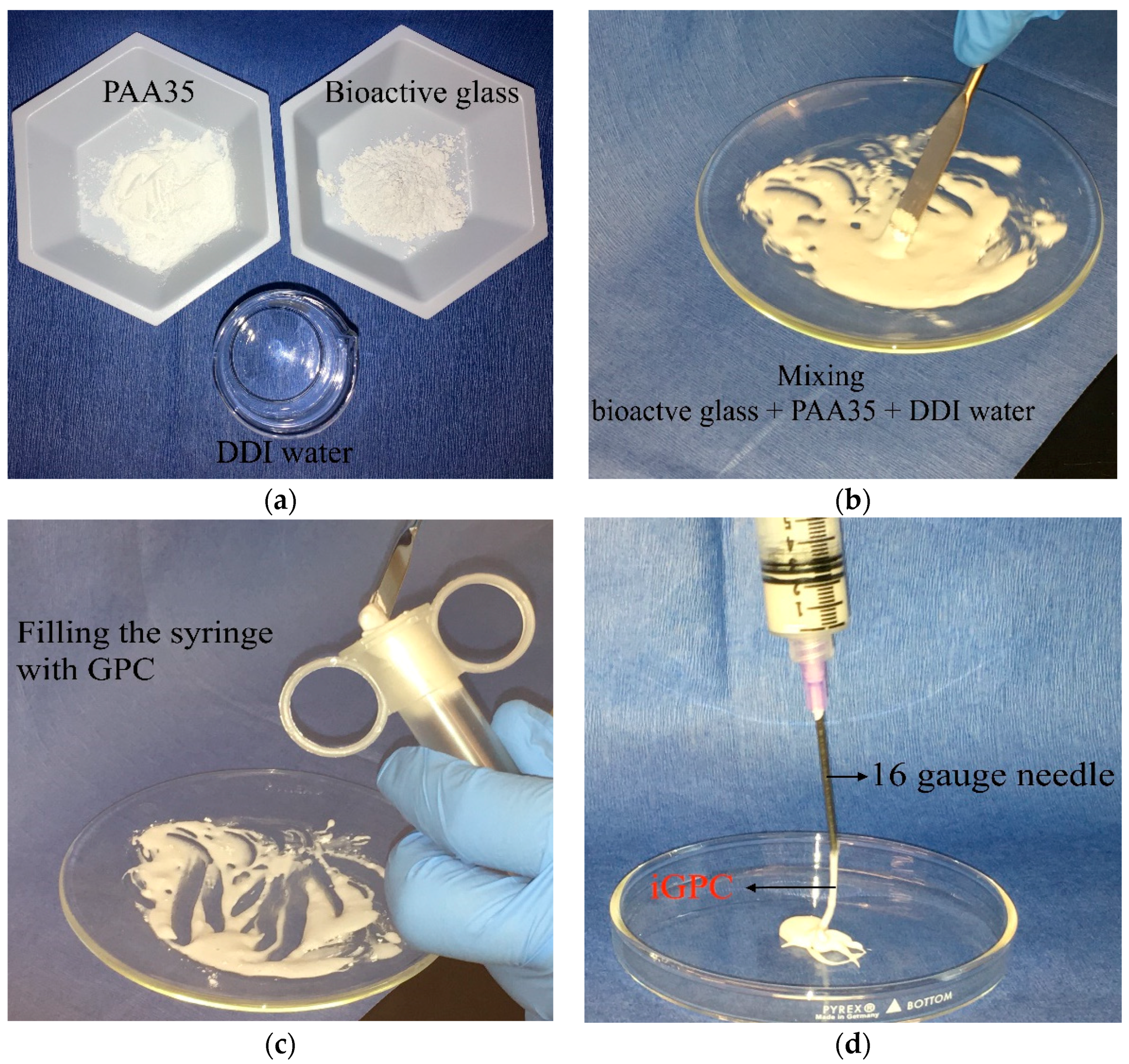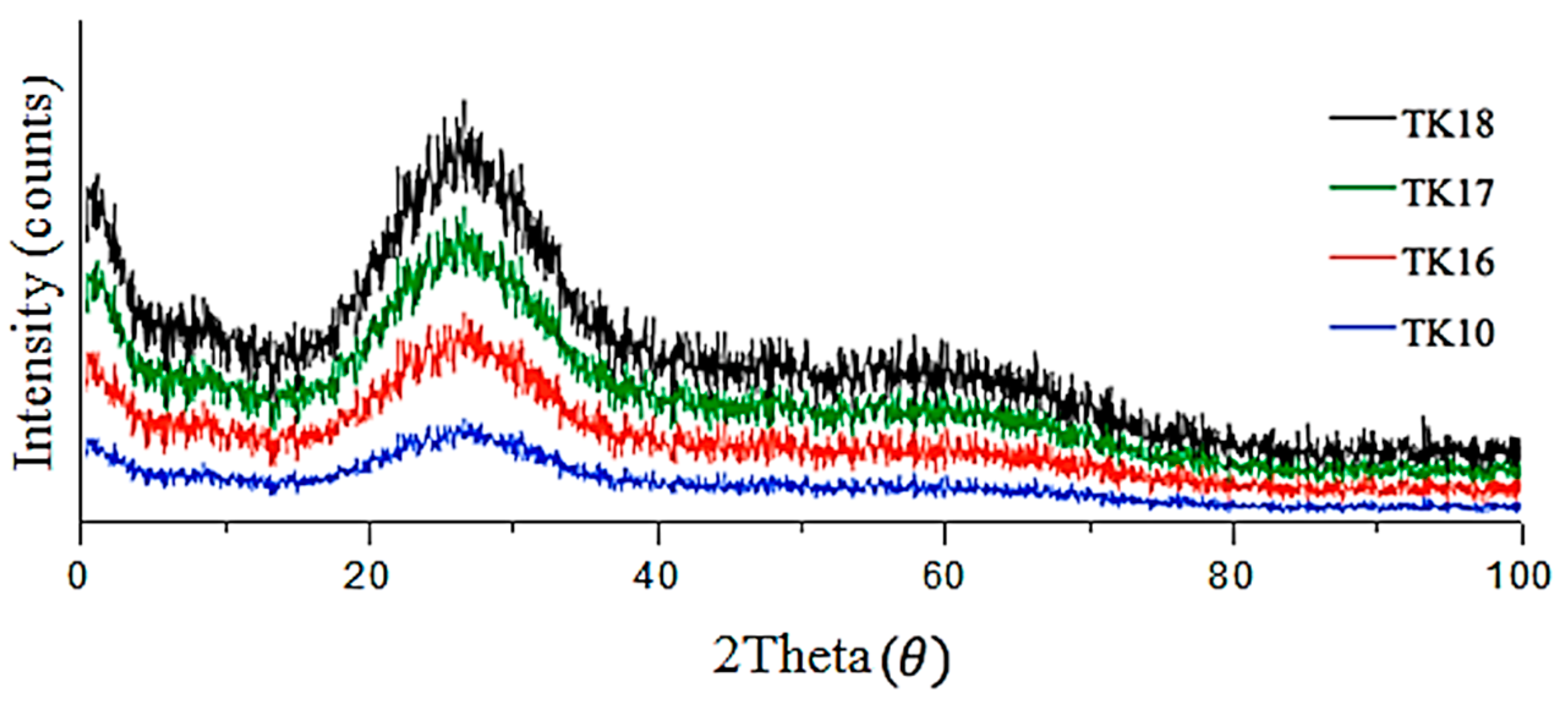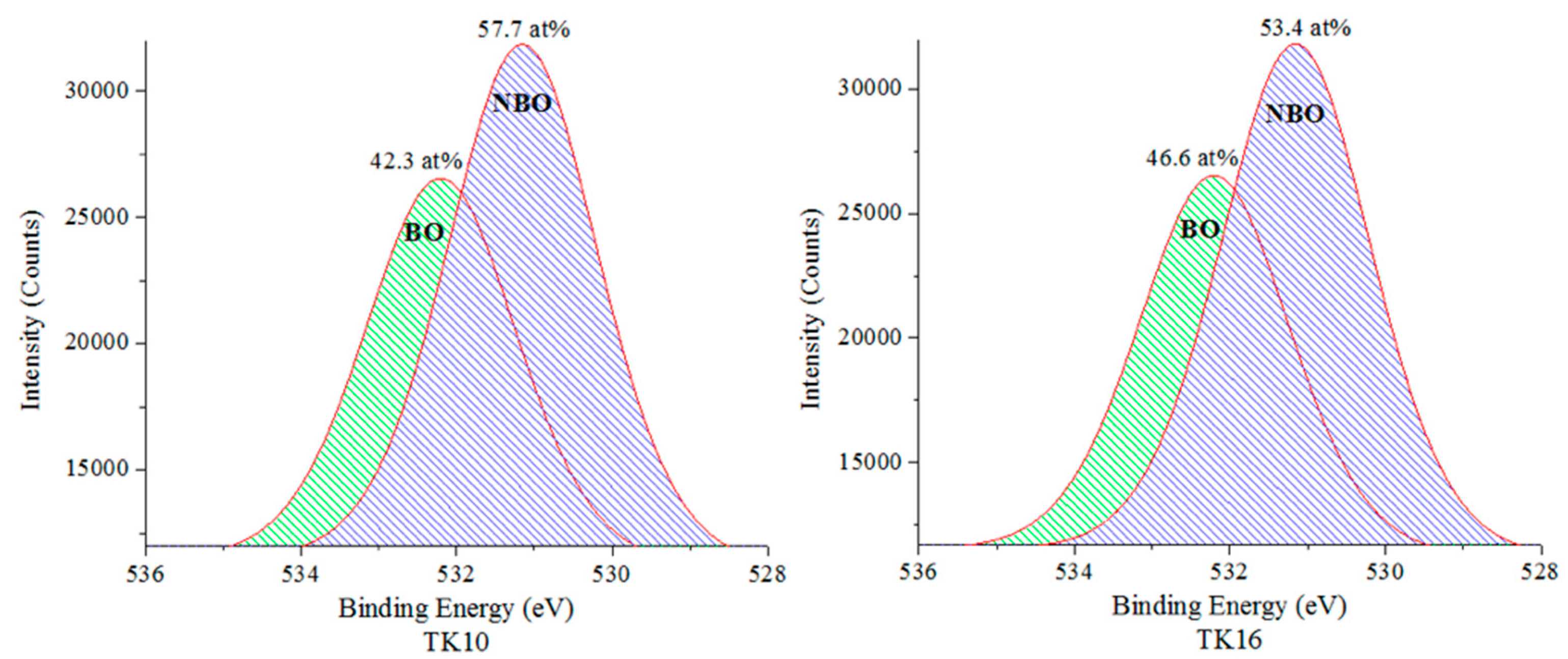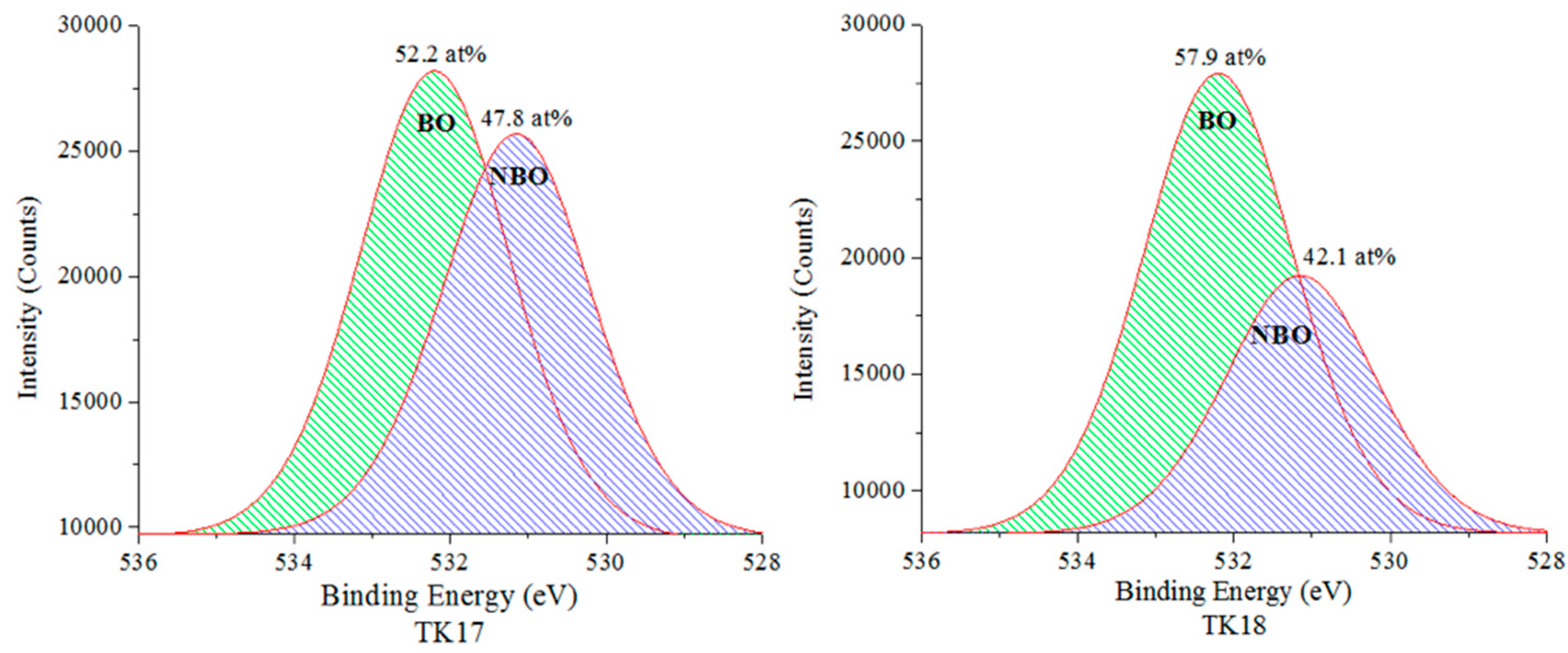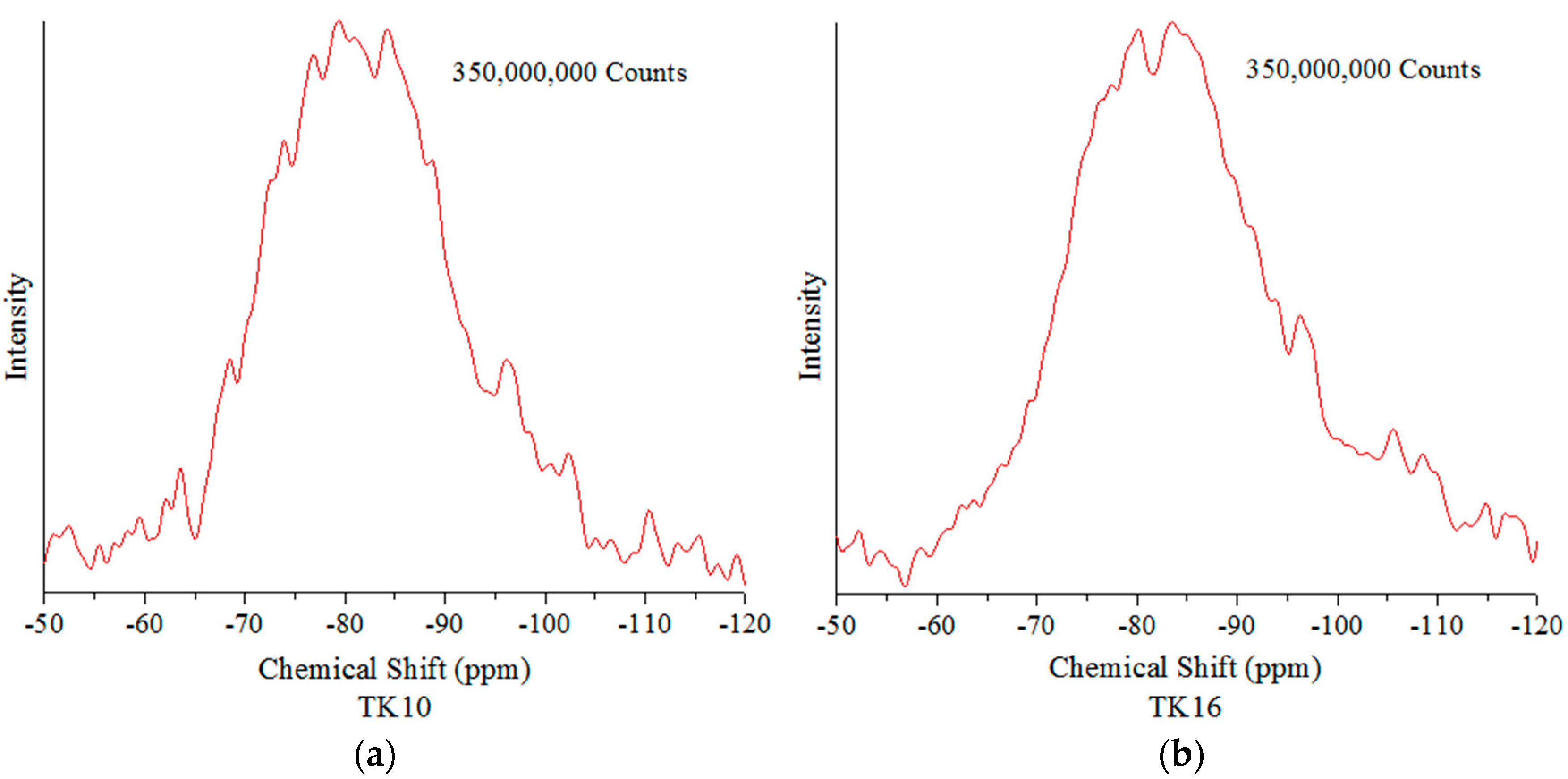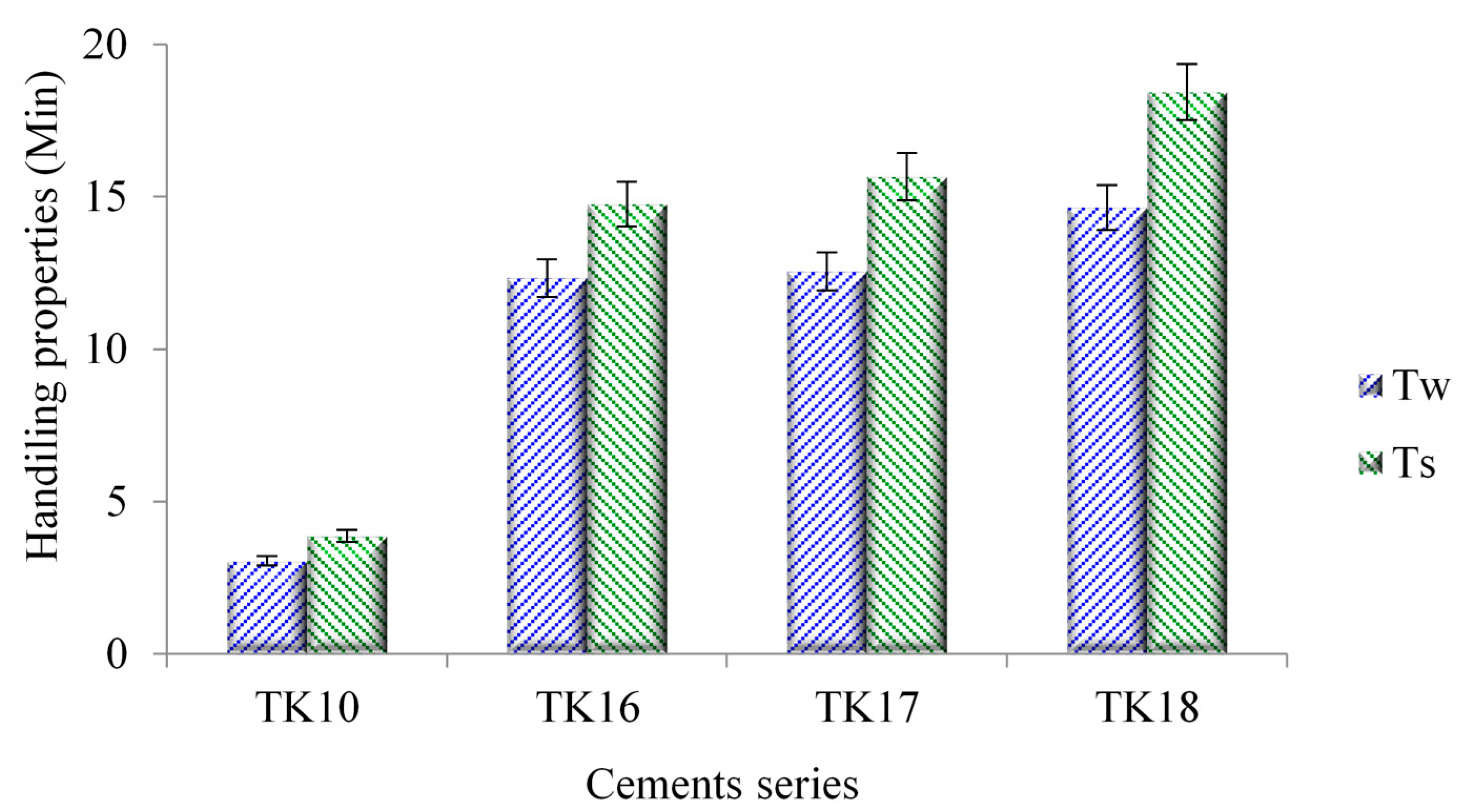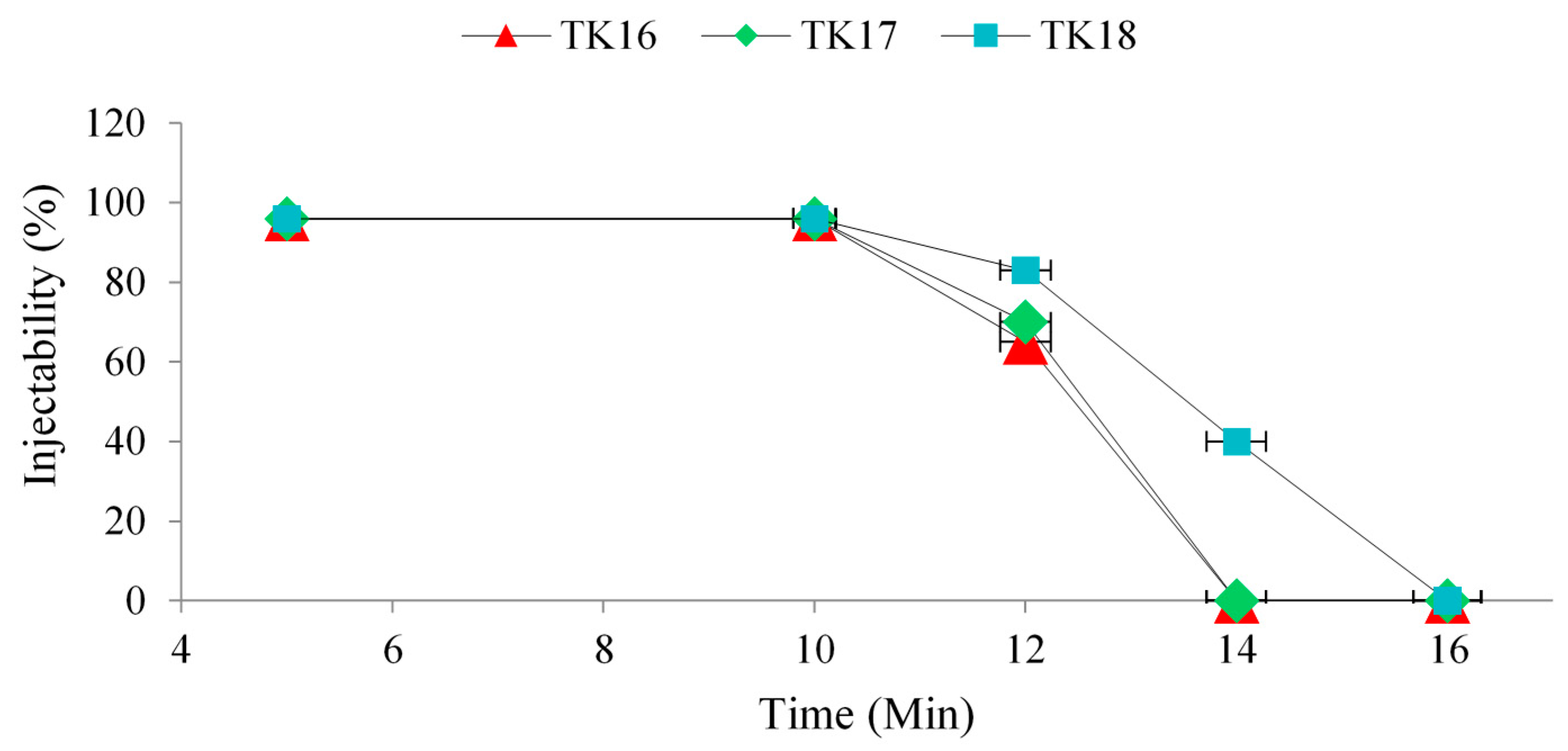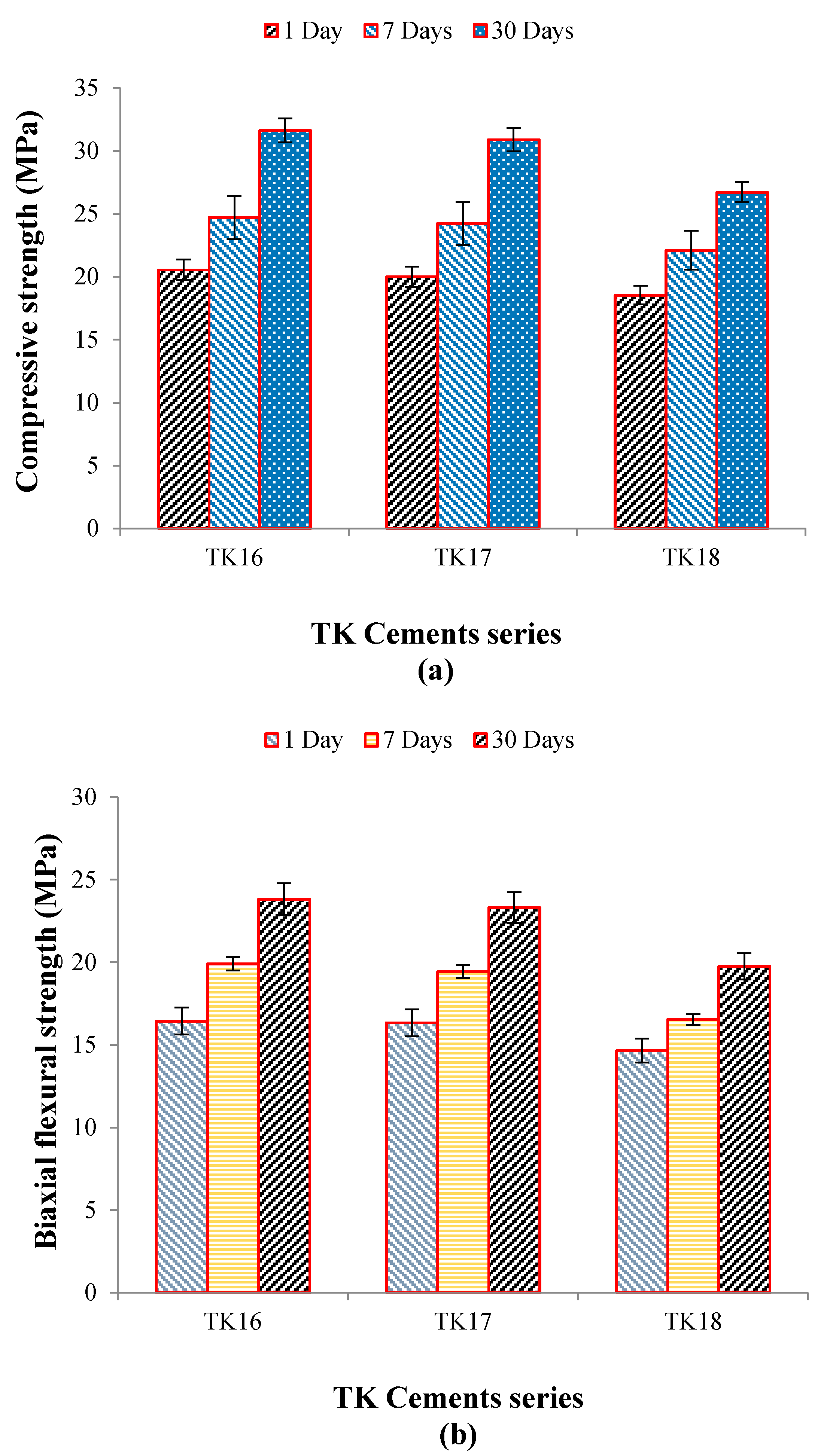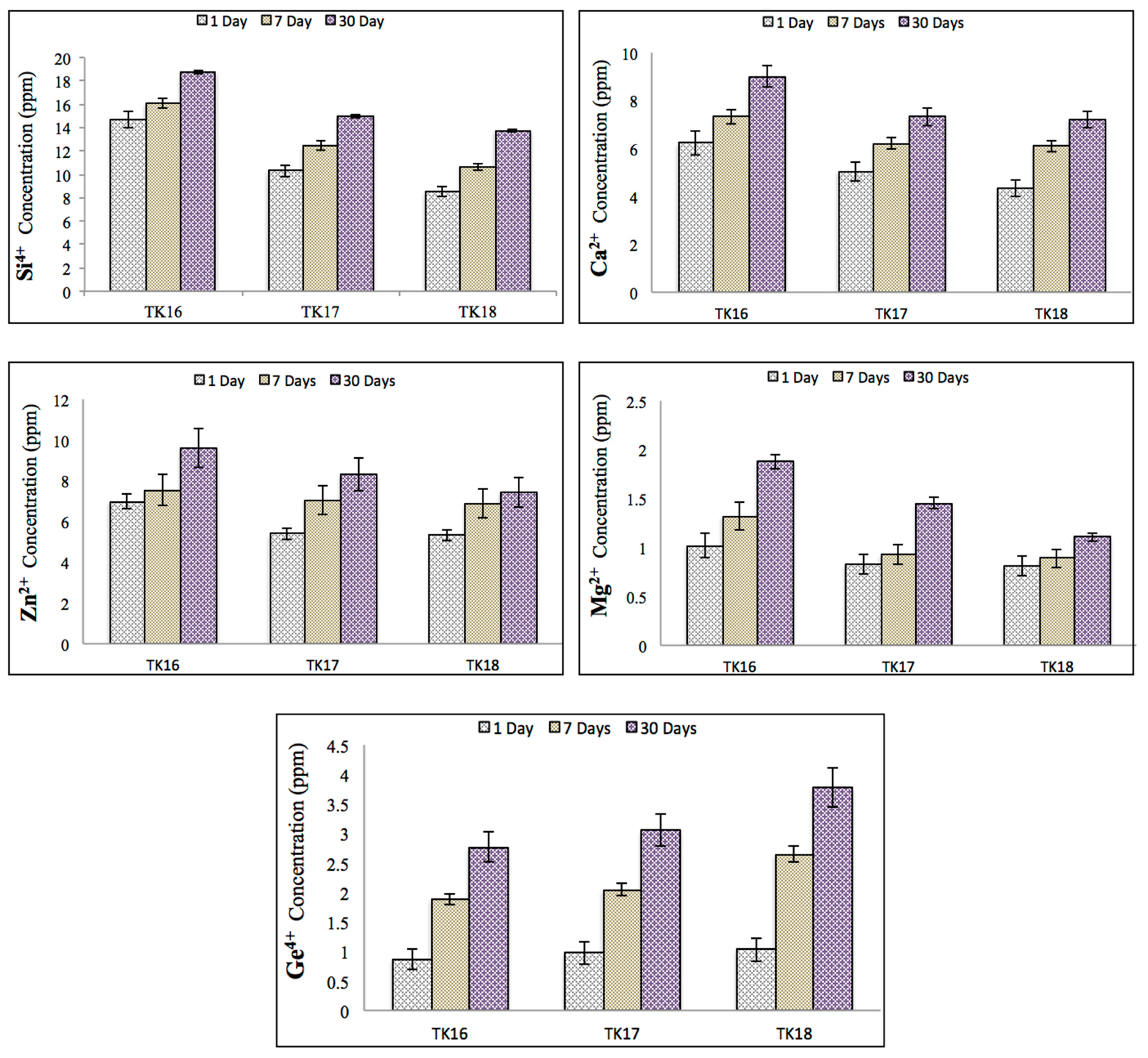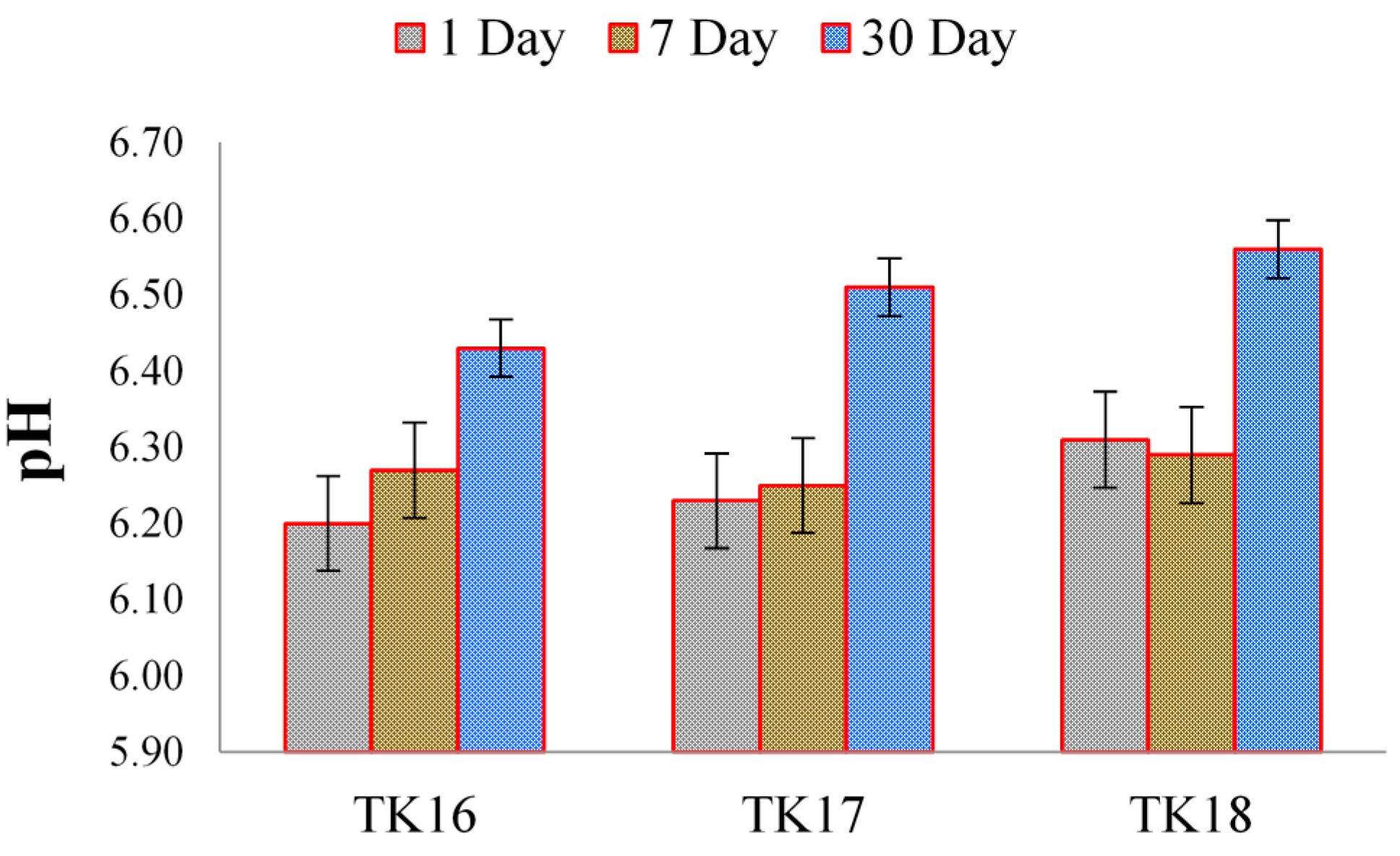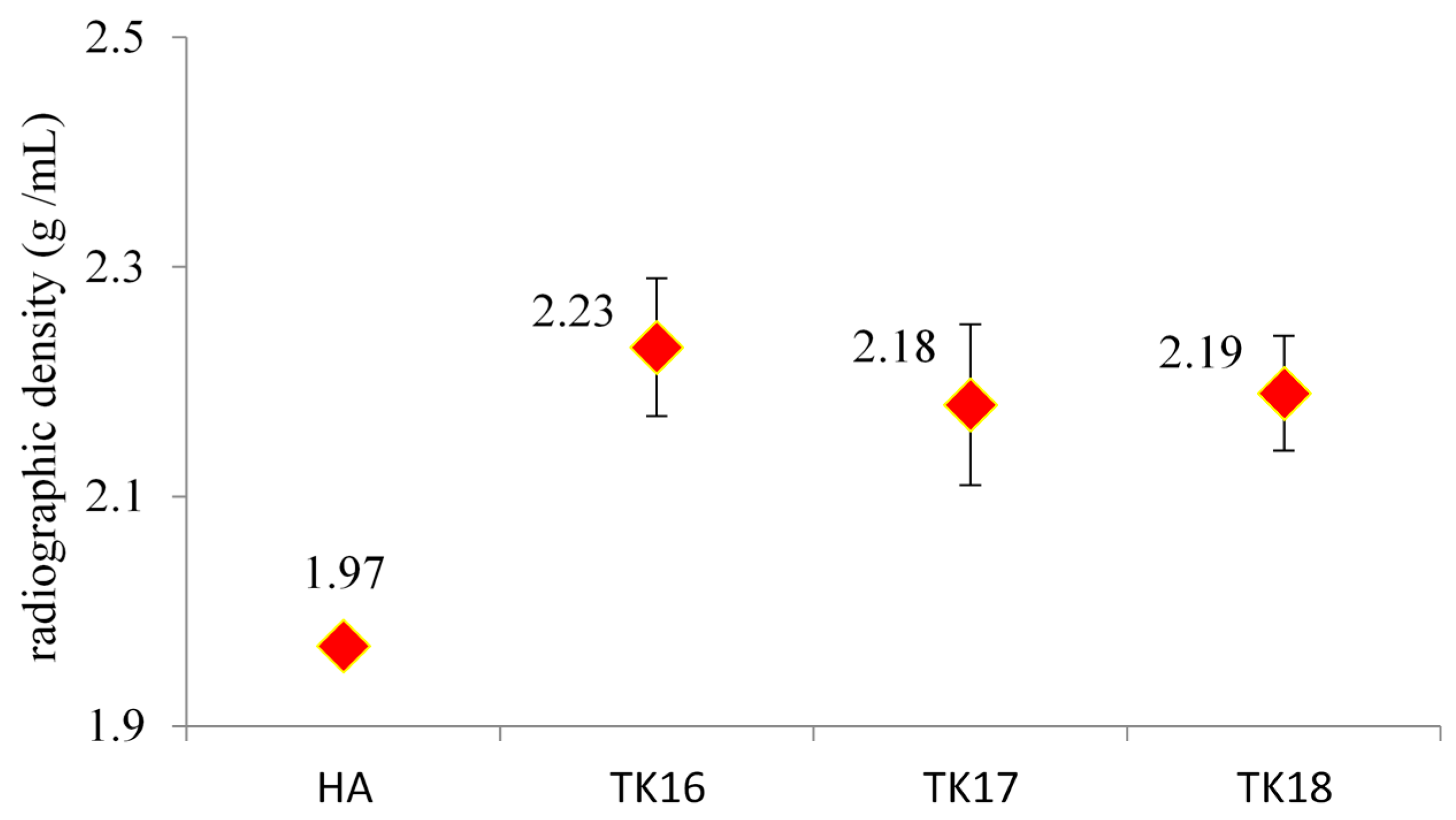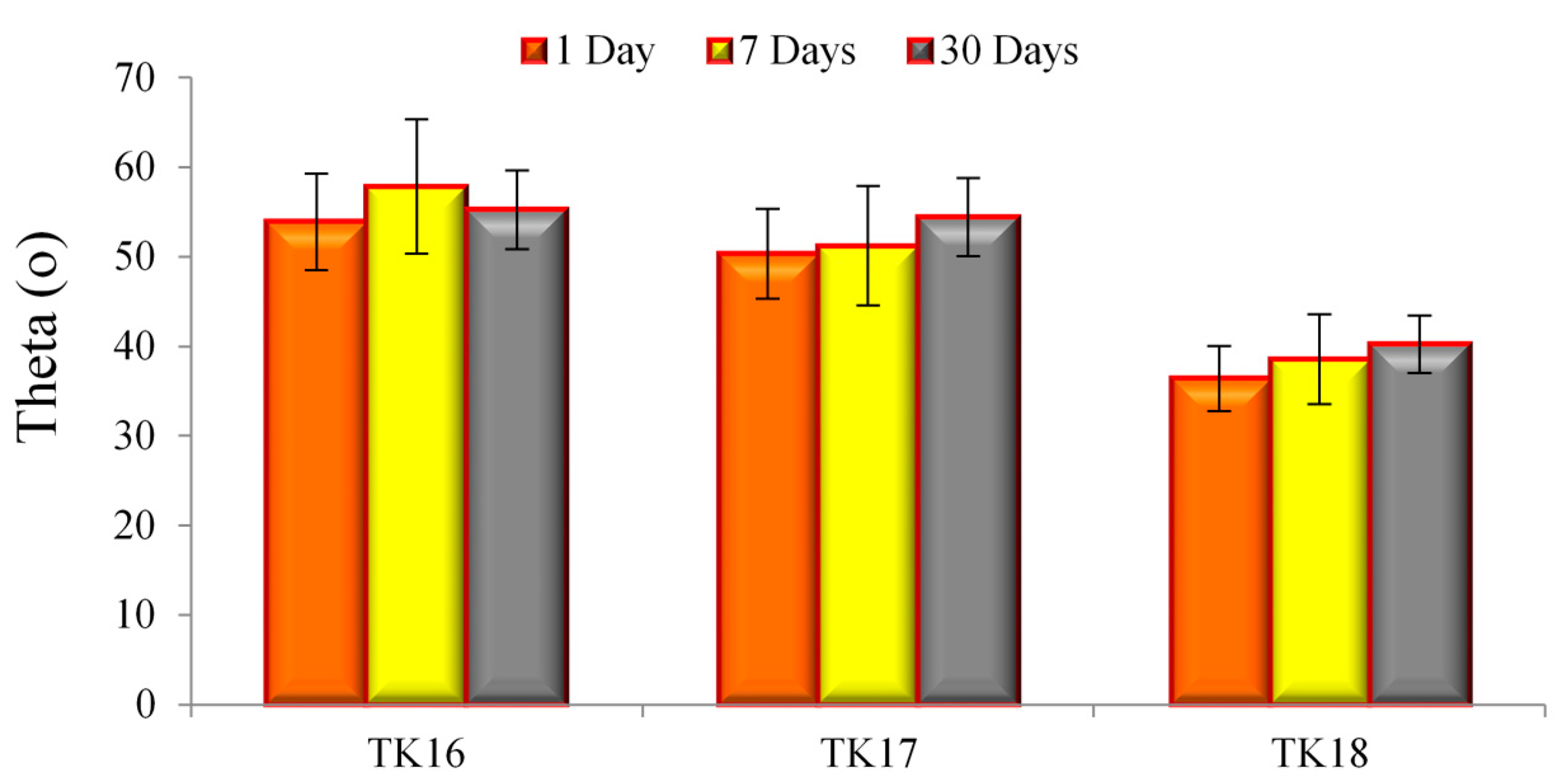Structural and Thermal Characterization of the Glass Series
XRD confirmed that no crystalline species were present in all the glass series after being fired. Therefore, it can be assumed that any change in the properties of the glasses would not be related to phase changes or separation in the glasses.
The particle size of the glass phase will impact the rheological properties of GPCs formulated from them; for example, increases in the surface area of the glass component will increase T
w and reduce T
s [
35]. However, all glasses had similar particle sizes (around 6 µm), and so it was fair to conclude that any measurable changes in handling properties of GPCs made from these glasses would be related to the chemistry, rather than physicality, of the glass phase.
Differential thermal analysis (DTA) was used to detect any changes in the
Tg as a result of the incorporation of Ge (
Table 4). In this instance a shift in
Tg can indicate that structural changes are occurring within the glass as the concentration of Ge was increased.
Tg was found to increase between TK10 and TK18 as the concentration of Ge was increased in the glass melt from 0 mol % (TK10) to 8 mol % (TK18). This shift suggests increased glass stability, which may be attributed to the formation of BO groups, which likely exists as Si–O–Ge groups are formed in the glass, agreeing with the network connectivity calculation. As expected the increase of BO requires increased energy to melt the glass [
32], therefore,
Tm increased from 1055 °C to 1139 °C with increasing Ge content up to 8 mol %. This was assumed to be due to the increasing ratio of BO:NBO when increasing the concentration of a former element (Ge).
XPS shows a shift of O1s that could be due to increased Ge concentration, in turn allowing for an increase in the at % of BO (
Figure 7). A decrease in the at % of O1s was found (15.6 at %) in the NBO content in the glass with the addition of 8 mol % Ge in the glass phase. As expected, Ge increases when substituted for Zn, the network connectivity as compared to the proportion acting as a former across the glass series increases. This agrees with previous work by the authors [
25], who found that the network connectivity increases while increasing the Ge concentration. The significant change in the BO:NBO ratio (
Figure 6) with the addition of 8 mol % of Ge was in agreement with the increased NC and the increased
Tg between TK10 and TK18 where Ge addition to the glass was a network former. The O1s peaks are broad with a full width at half maximum (FWHM) of peaks at ~1.9 eV suggesting a multi local environment of the oxygen atoms in terms of BO and NBO species. NBO groups (Si–O–NBO) are known to disrupt the glass network by depolymerizing the Si–O–Si bonds [
39]. This was regarded as a positive attribute as this facilitates the ion exchange process, which in turn increases bioactivity of these materials [
44,
45]. There is a constant interchange of ions among the set cement and the nearby body fluid or hard tissue [
46], the exchange of ions with surrounding tissues at the implant site is the basis of the osteo-conductive and bone-bonding properties associated with GPCs [
47]. Regarding this work, the O1s of the TK glass series containing Ge shifted to a higher BE which was indicative of increasing the BO content in the glass, therefore, expected to increase the handling properties of the iGPCs and allowing it to be an injectable cement [
25].
29Si MAS-NMR determined a chemical shift in ppm in a negative direction, as presented with TK16, TK17 and TK18, and was indicative of an increase in BO species attached to the Si within the glass [
25], aligning with the XPS results presented earlier in this manuscript (
Section 3.5). When BO content increases the peak will shift in a negative direction, and when NBO content increases the peak will shift in a positive direction [
25,
48,
49]. It was believed that Si resonances (−86 ppm) are linked with Q
3 species, while resonances that occur at −78 ppm are linked with Q
2 structures [
50]. It has been stated in the literature that
29Si resonances ranging from −60 and −83 ppm are linked with the Q
0/1 structural unit and that Q
2 structures are accepted to resonate at −78.9 ppm [
50]. Replacing Zn
2+ with Ge
4+ in the glass network has an effect on the glass structure, when replacing Ge
2+ for Zn
2+ there are slight chemical shift differences as shown in the
Figure 8.
Handling properties of the GPCs show a statistically significant difference (
p <0.05) with Ge incorporation from TK10 to TK18. The increasing trends experienced in both T
w (~3–15 min) and T
s (~4–18 min) resulted from the introduction of Ge to the glass phase, which may result in a decreased susceptibility to acid attack, the glasses releasing more cations into the environment, increasing carboxylic (COO-) metal bonding rates [
6]. The introduction of Ge ions, which have a 4+ charge, may also increase the bonding extend of the unbonded COO- molecular chains [
45]. NC increases with Ge content. However, decreasing ZnO content reduces preferential acid attacks on ZnO
4 sites, which lead to an increase in T
w and T
s, regardless of the increase in BOs, as confirmed by XPS [
51]. The difference in injectability between the three GPCs was due to the increase in Ge concentration. It was found that T
w and T
s increased in TK16, TK17 and TK18 with the addition of Ge as previously explained. TK10 was found to be uninjectable due to its short T
w and T
s. Thus, TK10 has been removed from further experiments in this paper.
Si/Zn-iGPCs (SiO
2-CaO-ZnO-Na
2O-GeO
2) previously reported by the authors exhibited
of ~37 MPa at 30 days maturation and T
s ~ 38 min [
25], comparable to the cements reported here which had
of ~33 MPa with shorter T
s ~13 min. TK16 with 6.5 mol % GeO
2 was found to have a longer setting time compared to TK10 with 0 mol % GeO
2 and a shorter T
s than the TK17 (7 mol % GeO
2) and TK18 (8 mol % GeO
2) (
Figure 11). This may be due to TK16 having a higher percentage of NBOs compared to TK17 and TK18, which results in a greater cross-linking of the PAA and increased
of the iGPCs [
32]. No significant difference (
p 0.05) was found in
and
between TK16 and TK17 cements. However, a significant decrease (
p = 0.008) was found in
between TK16 and TK18 and a significant decrease (
p = 0.032) was also found between TK17 and TK18 with respect to maturation after 30 days. There was a significant decrease (
p = 0.000) found in
between TK16 and TK18 and a significant decrease (
p = 0.008) was also found between TK17 and TK18 with respect to maturation after 30 days. Additionally, XPS results confirmed that a higher concentration of NBOs compared to BOs were present in the TK16 glass, as opposed to TK17 and TK18 glasses, increasing degradability of the glass network compared to the other glasses, therefore decreasing the mechanical properties [
30,
32].
The release of Si
4+, Ca
2+, Zn
2+ and Mg
2+ decreased with GeO
2 content (
Figure 12) and was also dependent on immersion time. This was expected as GeO
2 was substituted with ZnO in TK16, TK17 and TK18 up to 8 mol %, therefore, increasing the NC and allowing more ions to bond to the network of the glass phase to retard cement degradation.
Figure 12 (Ge) represents the release of Ge
4+ ions which was found to increase in TK16, TK17 and TK18 with increasing concentrations of Ge, peaking at ~2.8 ppm (TK16), ~3.1 ppm (TK17), ~3.8 ppm (TK18) after 30 days of immersion. Again, this is attributed to the longer setting reaction of cements with increased Ge content, which retards initial cross-linking after the attack of the PAA on the glass structure. This phenomenon can also be attributed to the slow reaction of the Ge
4+ ions with the carboxylic groups.
Micro-CT has confirmed that iGPCs are radiologically suited for long term monitoring. There were no changes found in the density of the iGPC series with the incorporation of GeO2.
Small contact angles (<90°) correspond to high wettability [
51]. Contact angle measurements were found to decrease with Ge incorporation, therefore, confirming the results of the setting reaction of the iGPCs in which the quicker set has a higher contact angle, and therefore, surface energy. Generally, all cement samples were found to be favorable to water (hydrophilic), it is assumed that the cell tissue of the bone has the ability to be seeded onto the surface of the iGPCs [
52].
